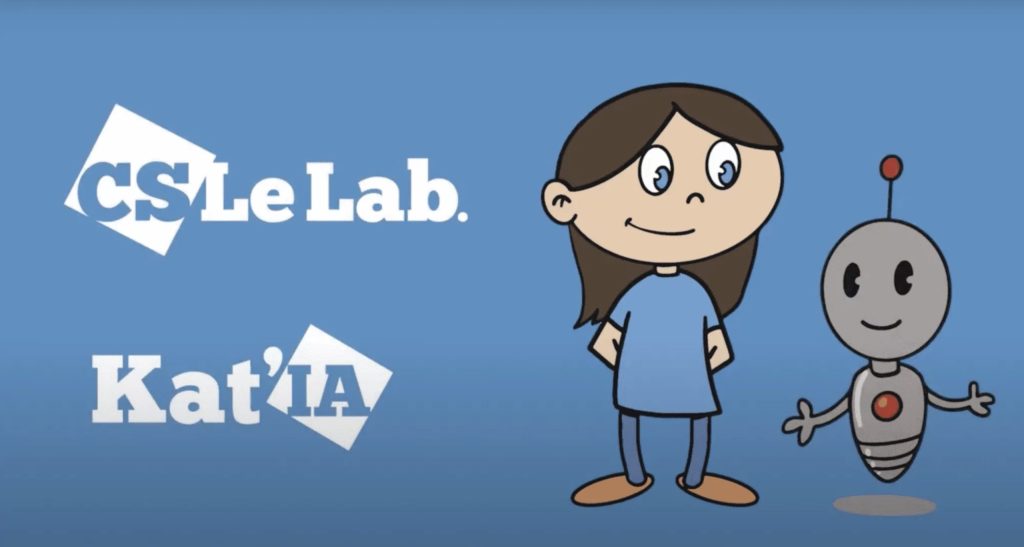Projet créatif, pédagogique et inclusif de CScience Le Lab, Kat’IA a rassemblé 66 écoliers de l’École primaire internationale Guy-Drummond à Outremont ainsi que des expertes de l’intelligence artificielle (IA). Une expérience qui profite maintenant à tous ceux qui souhaitent en connaître plus sur l’IA dans leur classe.
Cscience Le Lab a d’abord réuni Sasha Luccioni, experte chercheuse postdoctorat affiliée à Mila, un pôle mondial en intelligence artificiel au Québec, ainsi que Deepti Joshi, directrice scientifique du Centre de Développement et de Recherche en Intelligence Numérique (CDRIN). Elles se sont associées au dessinateur professionnel Vannara Ty, co-auteur de la série à succès La Moufette qui pète.
Ensemble, ils ont créé trois vidéos en dessins animés dans lesquels les personnages de Kat’IA et Algo expliquent aux enfants ce qu’est l’IA, comment elle fonctionne et qui sont ses meilleurs alliés, les algorithmes.
À cela s’ajoutent une dizaine de kits pédagogiques numériques destinés aux écoliers du Québec. L’objectif de ce matériel est de permettre aux élèves de partir à la découverte des nouvelles technologies et plus particulièrement de l’intelligence artificielle. Il aborde des notions théoriques et pratiques avec des activités à réaliser à l’école, avec les copains ou à la maison.
Mais au fait, Kat’IA, petit personnage futé et un tantinet espiègle, pourrait peut-être nous en dire davantage sur l’IA ?
ÉB : Qui sont tes parents, Kat’IA?
Kat’IA : Je suis née de l’imagination fertile de l’équipe de CScience Le Lab, qui souhaitait s’adresser aux enfants du primaire pour leur expliquer le merveilleux monde des algorithmes et de l’intelligence artificielle, d’où mon nom Kat’IA. I comme intelligence et A comme artificielle. Les élèves de 2e année de l’École Guy-Drummond m’ont donné vie grâce aux coups de crayon de Vannara Ty.
ÉB : Est-ce que l’intelligence artificielle concerne aussi les enfants?
Kat’IA : L’intelligence artificielle est partout! Dans les objets du quotidien et dans les décisions prises par nos ordinateurs. Alors oui, elle concerne aussi bien les parents, les professeurs que les enfants.
ÉB : Kat’IA, peux-tu nous donner des exemples d’intelligence artificielle dans le quotidien des enfants?
Kat’IA : Dans vos téléphones, il y a de l’IA, dans vos voitures, il y a de l’IA. Dans votre télévision, pour choisir quel film écouter, il y a aussi de l’IA. Et lorsque vous recherchez quelque chose sur Internet, il y a encore de l’IA. L’IA est partout, pour les petits comme pour les grands.
ÉB : Est-ce que l’IA nous aide à être plus intelligents?
Kat’IA : L’IA est un outil d’aide à la décision qui nous fait réaliser des choses que nous n’aurions pas remarquées sans elle. L’IA fait des liens entre de grandes quantités d’informations et nous aide à prendre de bonnes décisions.
ÉB : Comment a été la réception des enfants au projet de Kat’IA dans la classe de 2e année à l’École Guy-Drummond?
Kat’IA : Les enfants ont été enthousiastes dès le début du projet. Ils m’ont aidée à devenir qui je suis à travers toutes leurs idées, leur grande imagination et leurs pertinentes questions.
ÉB : Parle-nous un peu d’Algo?
Kat’IA : Algo est le plus fidèle compagnon qu’on puisse avoir, car il est toujours d’accord pour participer à de belles aventures avec les enfants. On l’a baptisé Algo en l’honneur des algorithmes, qui sont les meilleurs amis de l’IA.
ÉB : Est-ce que toi et Algo, vous pouvez aller dans d’autres écoles?
Kat’IA : Pour expliquer l’IA au plus grand nombre possible d’enfants du Québec, Algo et moi avons mis nos vidéos et nos clips pédagogiques en ligne sur Internet. Ils sont accessibles facilement et gratuitement pour les petits comme pour les grands. Et avec Algo, nous sommes ouverts à toutes les collaborations pour expliquer davantage la magie de l’IA.
ÉB : Comment fait-on pour vous inviter?
Kat’IA : Pour nous inviter avec Algo, c’est simple. Je vous donne rendez-vous sur ma page Internet : cscience.ca/katia
ÉB : Avant de se quitter, Kat’IA, et d’aller jouer avec les algorithmes, peux-tu nous dire s’il y aura d’autres capsules qui seront produites bientôt?
Kat’IA : Nos trois premières capsules expliquent l’IA. Mais nous avons plein d’autres idées pour rendre l’univers du numérique plus accessible aux enfants.
Il faudra donc surveiller le site Web de Kat’IA pour découvrir les prochaines nouveautés.






